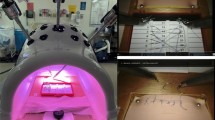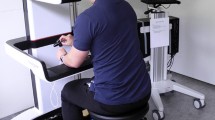Abstract
The objective of this randomized, controlled trial was to assess whether voluntary participation in a proctored, proficiency-based, virtual reality robotic suturing curriculum using the da Vinci® Skills Simulator™ improves robotic suturing performance. Residents and attending surgeons were randomized to participation or non-participation during a 5 week training curriculum. Robotic suturing skills were evaluated before and after training using an inanimate vaginal cuff model, which participants sutured for 10 min using the da Vinci® Surgical System. Performances were videotaped, anonymized, and subsequently graded independently by three robotic surgeons. 27 participants were randomized. 23 of the 27 completed both the pre- and post-test, 13 in the training group and 10 in the control group. Mean training time in the intervention group was 238 ± 136 min (SD) over the 5 weeks. The primary outcome (improvement in GOALS+ score) and the secondary outcomes (improvement in GEARS, total knots, satisfactory knots, and the virtual reality suture sponge 1 task) were significantly greater in the training group than the control group in unadjusted analysis. After adjusting for lower baseline scores in the training group, improvement in the suture sponge 1 task remained significantly greater in the training group and a trend was demonstrated to greater improvement in the training group for the GOALS+ score, GEARS score, total knots, and satisfactory knots.


Similar content being viewed by others
References
Reznick RK, MacRae H (2006) Teaching surgical skills––changes in the wind. N Engl J Med 355:2664–2669
Liss MA, McDougall EM (2013) Robotic surgical simulation. Cancer J 19:124–129
Hung AJ, Zehnder P, Patil MB, Cai J, Ng CK, Aron M et al (2011) Face, content and construct validity of a novel robotic surgery simulator. J Urol 186:1019–1024
Alzahrani THR, Alkhayal A, Delisle J, Drudi L, Gotlieb W, Fraser S, Bergman S, Bladou F, Andonian S, Anidjar M (2013) Validation of the da Vinci Surgical Skill Simulator across three surgical disciplines: a pilot study. Can Urol Assoc J 7:e520–e529
Lee JY, Mucksavage P, Kerbl DC, Huynh VB, Etafy M, McDougall EM (2012) Validation study of a virtual reality robotic simulator—role as an assessment tool? J Urol 187:998–1002
Hung AJ, Jayaratna IS, Teruya K, Desai MM, Gill IS, Goh AC (2013) Comparative assessment of three standardized robotic surgery training methods. BJU Int 112:864–871
Abboudi H, Khan MS, Aboumarzouk O, Guru KA, Challacombe B, Dasgupta P et al (2013) Current status of validation for robotic surgery simulators—a systematic review. BJU Int 111:194–205
Fried GM, Feldman LS, Vassiliou MC, Fraser SA, Stanbridge D, Ghitulescu G et al (2004) Proving the value of simulation in laparoscopic surgery. Ann Surg 240:518–525 (discussion 25–8)
Carter FJ, Schijven MP, Aggarwal R, Grantcharov T, Francis NK, Hanna GB et al (2005) Consensus guidelines for validation of virtual reality surgical simulators. Surg Endosc 19:1523–1532
Hung AJ, Patil MB, Zehnder P, Cai J, Ng CK, Aron M et al (2012) Concurrent and predictive validation of a novel robotic surgery simulator: a prospective, randomized study. J Urol 187:630–637
Vaccaro CM, Crisp CC, Fellner AN, Jackson C, Kleeman SD, Pavelka J (2013) Robotic virtual reality simulation plus standard robotic orientation versus standard robotic orientation alone: a randomized controlled trial. Female Pelvic Med Reconstr Surg 19:266–270
Sroka G, Feldman LS, Vassiliou MC, Kaneva PA, Fayez R, Fried GM (2010) Fundamentals of laparoscopic surgery simulator training to proficiency improves laparoscopic performance in the operating room—a randomized controlled trial. Am J Surg 199:115–120
Dulan G, Rege RV, Hogg DC, Gilberg-Fisher KM, Arain NA, Tesfay ST et al (2012) Proficiency-based training for robotic surgery: construct validity, workload, and expert levels for nine inanimate exercises. Surg Endosc 26:1516–1521
Dulan G, Rege RV, Hogg DC, Gilberg-Fisher KK, Tesfay ST, Scott DJ (2012) Content and face validity of a comprehensive robotic skills training program for general surgery, urology, and gynecology. Am J Surg 203:535–539
Palter VN, Graafland M, Schijven MP, Grantcharov TP (2012) Designing a proficiency-based, content validated virtual reality curriculum for laparoscopic colorectal surgery: a Delphi approach. Surgery 151:391–397
Rosenthal ME, Ritter EM, Goova MT, Castellvi AO, Tesfay ST, Pimentel EA et al (2010) Proficiency-based fundamentals of laparoscopic surgery skills training results in durable performance improvement and a uniform certification pass rate. Surg Endosc 24:2453–2457
Scott DJ, Ritter EM, Tesfay ST, Pimentel EA, Nagji A, Fried GM (2008) Certification pass rate of 100% for fundamentals of laparoscopic surgery skills after proficiency-based training. Surg Endosc 22:1887–1893
Schulz KF, Grimes DA (2002) Allocation concealment in randomised trials: defending against deciphering. Lancet 359:614–618
Finan MA, Rocconi CM (2010) A novel method for training residents in robotic hysterectomy. J Robot Surg 4:33–39
Vassiliou MC, Feldman LS, Andrew CG, Bergman S, Leffondre K, Stanbridge D et al (2005) A global assessment tool for evaluation of intraoperative laparoscopic skills. Am J Surg 190:107–113
Goh AC, Goldfarb DW, Sander JC, Miles BJ, Dunkin BJ (2012) Global evaluative assessment of robotic skills: validation of a clinical assessment tool to measure robotic surgical skills. J Urol 187:247–252
PASS: Power analysis and sample size software. http://www.ncss.com/software/pass/. Accessed 6 Feb 2015
Arain NA, Dulan G, Hogg DC, Rege RV, Powers CE, Tesfay ST et al (2012) Comprehensive proficiency-based inanimate training for robotic surgery: reliability, feasibility, and educational benefit. Surg Endosc 26:2740–2745
Marecik SJ, Prasad LM, Park JJ, Pearl RK, Evenhouse RJ, Shah A et al (2008) A lifelike patient simulator for teaching robotic colorectal surgery: how to acquire skills for robotic rectal dissection. Surg Endosc 22:1876–1881
Kiely DJ, Gotlieb WH, Jardon K, Lau S, Press JZ (2015) Advancing surgical simulation in gynecologic oncology: robotic dissection of a novel pelvic lymphadenectomy model. Simul Healthc 10:38–42
Conflict of interest
Authors Kiely, Gotlieb, Lau, Zeng, Samouelian, Ramanakumar, Zakrzewski, Brin, Fraser, Korsieporn, Drudi, and Press declare that they have no conflict of interest.
Informed consent
Informed consent was obtained from all study participants.
Compliance with ethical standards
All procedures performed in this study were in accordance with the ethical standards of the McGill Faculty of Medicine Institutional Review Board and with the 1964 Helsinki declaration and its later amendments.
Author information
Authors and Affiliations
Corresponding author
Additional information
Condensation: In this randomized controlled trial, learners randomized to participation in a virtual reality robotic suturing curriculum showed a trend towards greater improvement when scored on their ability to suture an inanimate vaginal cuff model using the da Vinci® Surgical System.
ClinicalTrials.gov: NCT01811095, www.clinicaltrials.gov.
Electronic supplementary material
Below is the link to the electronic supplementary material.
Supplementary material 1 (MP4 114368 kb)
Rights and permissions
About this article
Cite this article
Kiely, D.J., Gotlieb, W.H., Lau, S. et al. Virtual reality robotic surgery simulation curriculum to teach robotic suturing: a randomized controlled trial. J Robotic Surg 9, 179–186 (2015). https://doi.org/10.1007/s11701-015-0513-4
Received:
Accepted:
Published:
Issue Date:
DOI: https://doi.org/10.1007/s11701-015-0513-4




